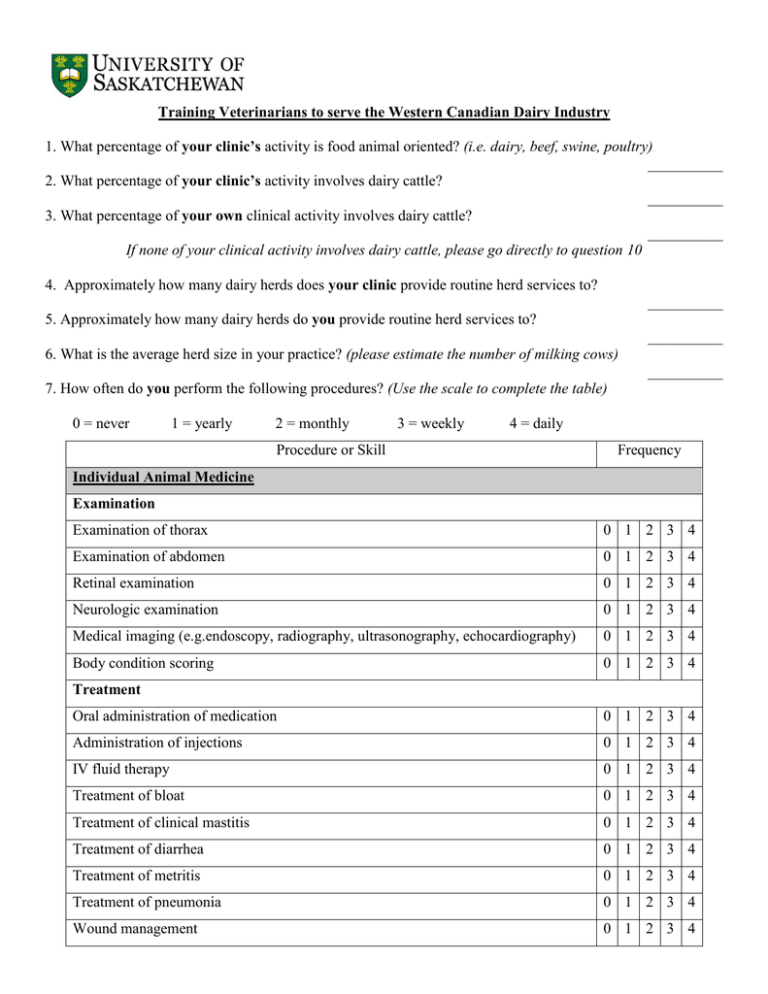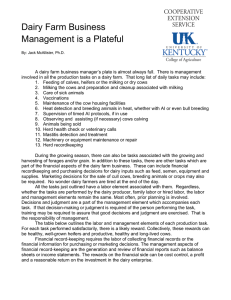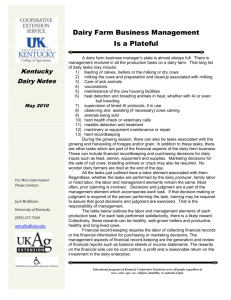Document 12087742
advertisement

Training Veterinarians to serve the Western Canadian Dairy Industry 1. What percentage of your clinic’s activity is food animal oriented? (i.e. dairy, beef, swine, poultry) __________ 2. What percentage of your clinic’s activity involves dairy cattle? __________ 3. What percentage of your own clinical activity involves dairy cattle? __________ If none of your clinical activity involves dairy cattle, please go directly to question 10 4. Approximately how many dairy herds does your clinic provide routine herd services to? __________ 5. Approximately how many dairy herds do you provide routine herd services to? __________ 6. What is the average herd size in your practice? (please estimate the number of milking cows) __________ 7. How often do you perform the following procedures? (Use the scale to complete the table) 0 = never 1 = yearly 2 = monthly 3 = weekly 4 = daily Procedure or Skill Frequency Individual Animal Medicine Examination Examination of thorax 0 1 2 3 4 Examination of abdomen 0 1 2 3 4 Retinal examination 0 1 2 3 4 Neurologic examination 0 1 2 3 4 Medical imaging (e.g.endoscopy, radiography, ultrasonography, echocardiography) 0 1 2 3 4 Body condition scoring 0 1 2 3 4 Treatment Oral administration of medication 0 1 2 3 4 Administration of injections 0 1 2 3 4 IV fluid therapy 0 1 2 3 4 Treatment of bloat 0 1 2 3 4 Treatment of clinical mastitis 0 1 2 3 4 Treatment of diarrhea 0 1 2 3 4 Treatment of metritis 0 1 2 3 4 Treatment of pneumonia 0 1 2 3 4 Wound management 0 1 2 3 4 Transfaunation 0 1 2 3 4 Subconjunctival injection 0 1 2 3 4 Reproduction Breeding soundness examination (cow) 0 1 2 3 4 Breeding soundness examination (bull) 0 1 2 3 4 Artificial insemination 0 1 2 3 4 Embryo transfer 0 1 2 3 4 Pregnancy detection by palpation per rectum 0 1 2 3 4 Ultrasonographic pregnancy diagnosis 0 1 2 3 4 Management of dystocia 0 1 2 3 4 Diagnostics Abdominocentesis 0 1 2 3 4 Cerebrospinal fluid collection 0 1 2 3 4 Liver biopsy 0 1 2 3 4 Rumenocentesis 0 1 2 3 4 Respiratory tract sampling (e.g. nasal swabbing, transtracheal aspiration) 0 1 2 3 4 Tissue sampling (e.g. aspirate or biopsy) 0 1 2 3 4 Bacteriologic culturing (including milk) 0 1 2 3 4 California Mastitis Test 0 1 2 3 4 CBC and/or serum chemistry analysis 0 1 2 3 4 Cytologic examination 0 1 2 3 4 Fecal floatation and/or quantitative fecal examination 0 1 2 3 4 Necropsy 0 1 2 3 4 Urinalysis 0 1 2 3 4 Surgery IV or IM sedation 0 1 2 3 4 General anesthesia 0 1 2 3 4 Casting (for restraint) 0 1 2 3 4 Castration 0 1 2 3 4 Dehorning 0 1 2 3 4 Tail docking 0 1 2 3 4 Branding 0 1 2 3 4 Ovariectomy 0 1 2 3 4 Penile and/or preputial surgery 0 1 2 3 4 Urethral surgery (e.g. urethroplasty, urethrostomy) 0 1 2 3 4 Cesarean section 0 1 2 3 4 Post-calving repair (e.g. uterine or vaginal prolapse, rectovaginal laceration or fistula) 0 1 2 3 4 Surgical correction of displaced abomasum 0 1 2 3 4 Abomasopexy by toggle 0 1 2 3 4 Rumen surgery (e.g. temporary rumenostomy or rumenotomy) 0 1 2 3 4 Intestinal resection and anastomosis 0 1 2 3 4 Umbilical surgery (e.g. umbilical herniorrhaphy or resection) 0 1 2 3 4 Exploratory laparotomy 0 1 2 3 4 Eyelid or eyeball surgery 0 1 2 3 4 Teat surgery (e.g. repair teat obstruction, supranumary teat removal) 0 1 2 3 4 Digit surgery (e.g. excision of interdigital fibroma, digit amputation) 0 1 2 3 4 Orthopedic repair (e.g. splinting, fracture repair by casting or other means) 0 1 2 3 4 Joint lavage or arthrocentesis 0 1 2 3 4 Animal Production Development of vaccination programs 0 1 2 3 4 Development of an anthelmintic/ insecticide program 0 1 2 3 4 Control of a disease outbreak in a herd (e.g. respiratory or diarrhea) 0 1 2 3 4 Control of a lameness problem in a herd 0 1 2 3 4 Control of an off-feed or nutrition problem in a herd 0 1 2 3 4 Ration formulation 0 1 2 3 4 Estrus synchronization 0 1 2 3 4 Advising about genetics or breeding 0 1 2 3 4 Residue avoidance program 0 1 2 3 4 Assessment of replacement heifer management 0 1 2 3 4 Assessment of milking procedures and/or milking machine performance 0 1 2 3 4 Advising about waste management 0 1 2 3 4 Mastitis consultation (e.g. somatic cell count, bulk tank analysis) 0 1 2 3 4 Assessment of records (e.g. DHI, computer, spreadsheets) 0 1 2 3 4 Assessment of housing or ventilation 0 1 2 3 4 Economic analysis/ financial advising 0 1 2 3 4 Development of vaccination programs 0 1 2 3 4 8. What are the 3 procedures or skills for which it is important that veterinarians entering dairy practice have a high level of proficiency in? (not limited to the previously listed procedures or skills) 1. __________________________________________________________________________________ 2. __________________________________________________________________________________ 3. __________________________________________________________________________________ 9. What are the 3 procedures or skills for which veterinarians entering dairy practice are least well prepared? (not limited to the previously listed procedures or skills) 1. __________________________________________________________________________________ 2. __________________________________________________________________________________ 3. __________________________________________________________________________________ 10. What is your name? ________________________________________ 11. In what year did you graduate with your DVM? ____________________ 12. How many other dairy veterinarians are in your practice? __________ 13. Comments: __________________________________________________________________________________________ __________________________________________________________________________________________ __________________________________________________________________________________________ __________________________________________________________________________________________ Thank-you for taking the time to complete this survey.





